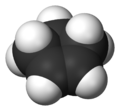Bob
Have a question related to this hub?
Alice
Got something to say related to this hub?
Share it here.
| |||
 | |||
| Names | |||
|---|---|---|---|
| Preferred IUPAC name
Cyclopentene | |||
| Identifiers | |||
3D model (JSmol)
|
|||
| ChEBI | |||
| ChEMBL | |||
| ChemSpider | |||
| ECHA InfoCard | 100.005.030 | ||
PubChem CID
|
|||
| UNII | |||
CompTox Dashboard (EPA)
|
|||
| |||
| |||
| Properties | |||
| C5H8 | |||
| Molar mass | 68.11 g/mol | ||
| Density | 0.771 g/cm3 | ||
| Melting point | −135 °C (−211 °F; 138 K) | ||
| Boiling point | 44 to 46 °C (111 to 115 °F; 317 to 319 K) | ||
| Hazards | |||
| NFPA 704 (fire diamond) | |||
| Flash point | −29 °C (−20 °F; 244 K) | ||
| Related compounds | |||
Related compounds
|
Cyclopentadiene Cyclobutene | ||
Except where otherwise noted, data are given for materials in their standard state (at 25 °C [77 °F], 100 kPa).
| |||
Cyclopentene is a chemical compound with the formula (CH2)3(CH)2. It is a colorless liquid with a petrol-like odor. It has few applications, and thus is mainly used as a minor component of gasoline, present in concentrations of less than 1%.[1][2] It is one of the principal cycloalkenes.
Cyclopentene was first prepared by Carl Gärtner in 1893 from iodocyclopentane with potassium hydroxide. He named it pentamethenylene (German: Pentamethenylen).[3]
Cyclopentene is produced industrially in large amounts by steam cracking of naphtha. In the laboratory, it is prepared by dehydration of cyclopentanol.[4] Substituted cyclopentenes are the product of the vinylcyclopropane-cyclopentene rearrangement.[5]
It can also be produced by the catalytic hydrogenation of cyclopentadiene.[6]
The polymerization of cyclopentene by Ziegler-Natta catalysts yields 1,3-linkages, not the more typical 1,2-linked polymer.[7]
Palladium-catalyzed hydrocarboxylation of cyclopentene gives cyclopentanecarboxylic acid:[8]